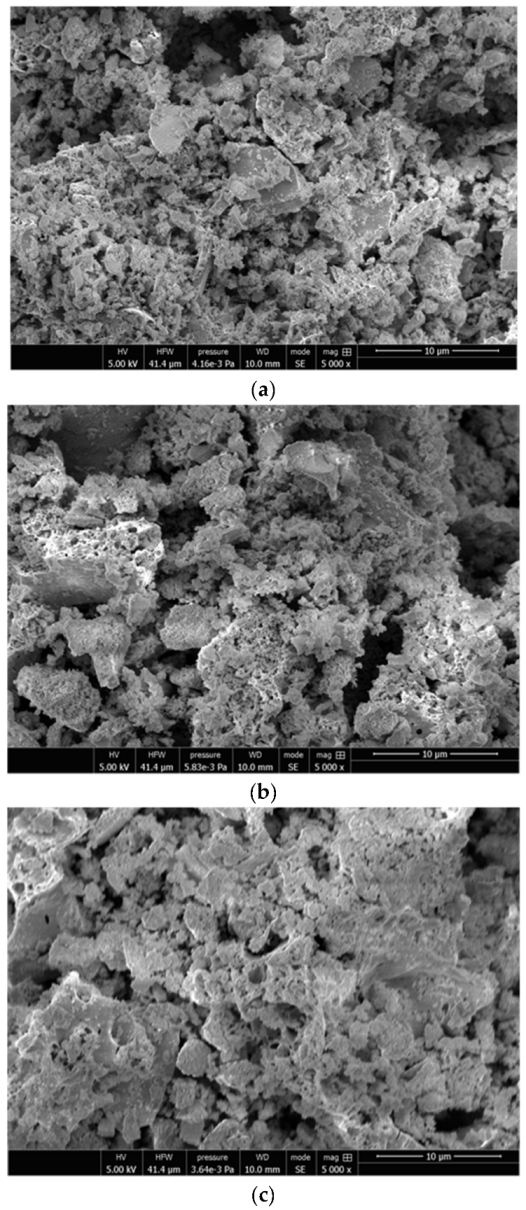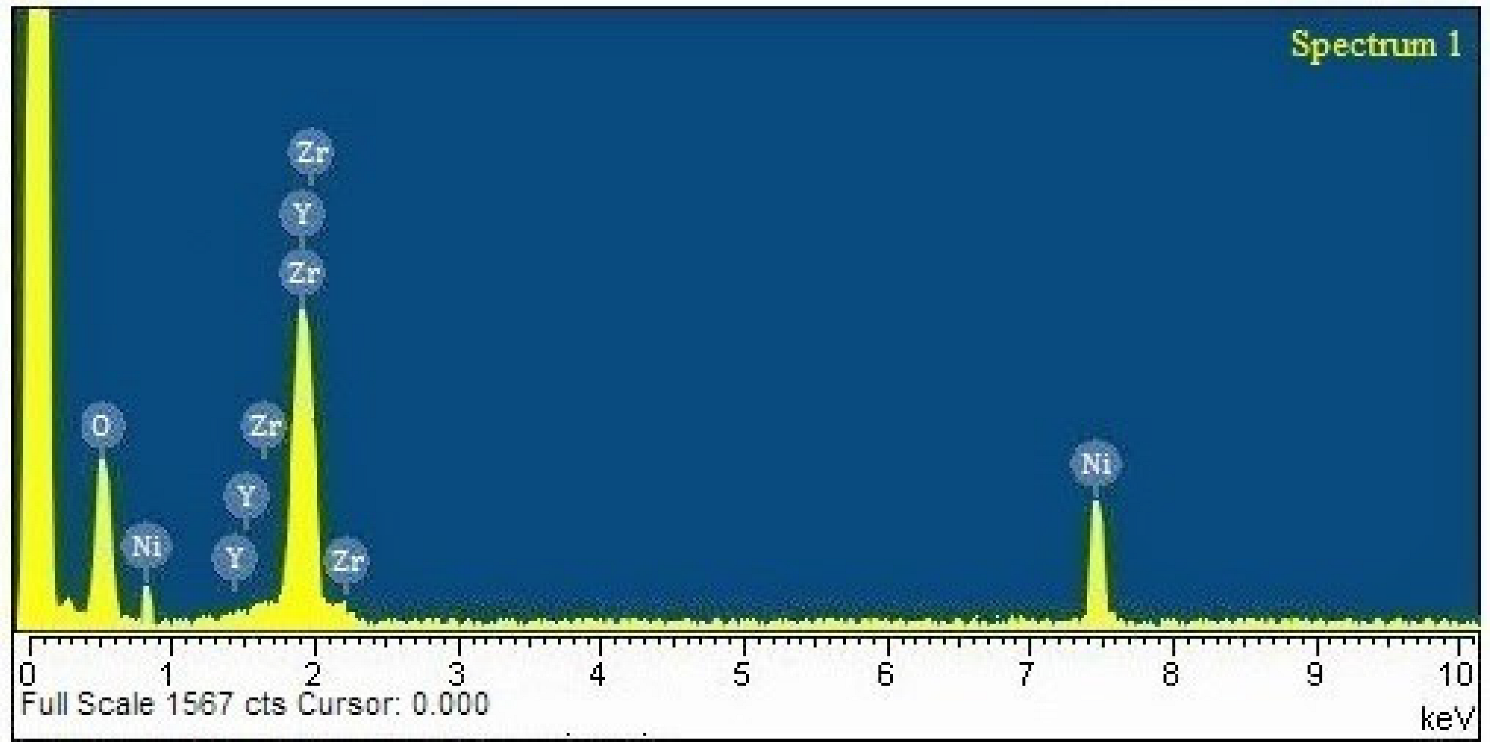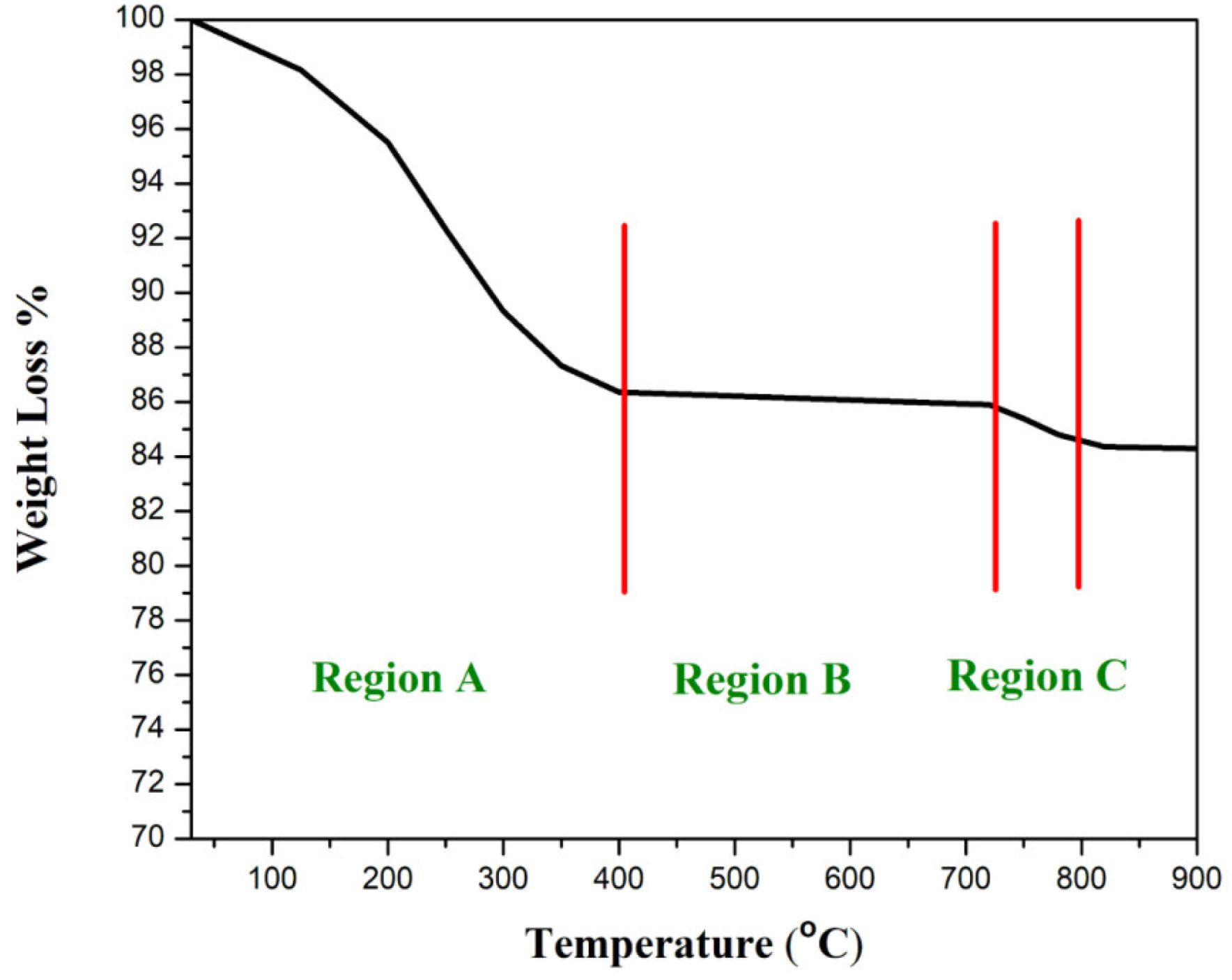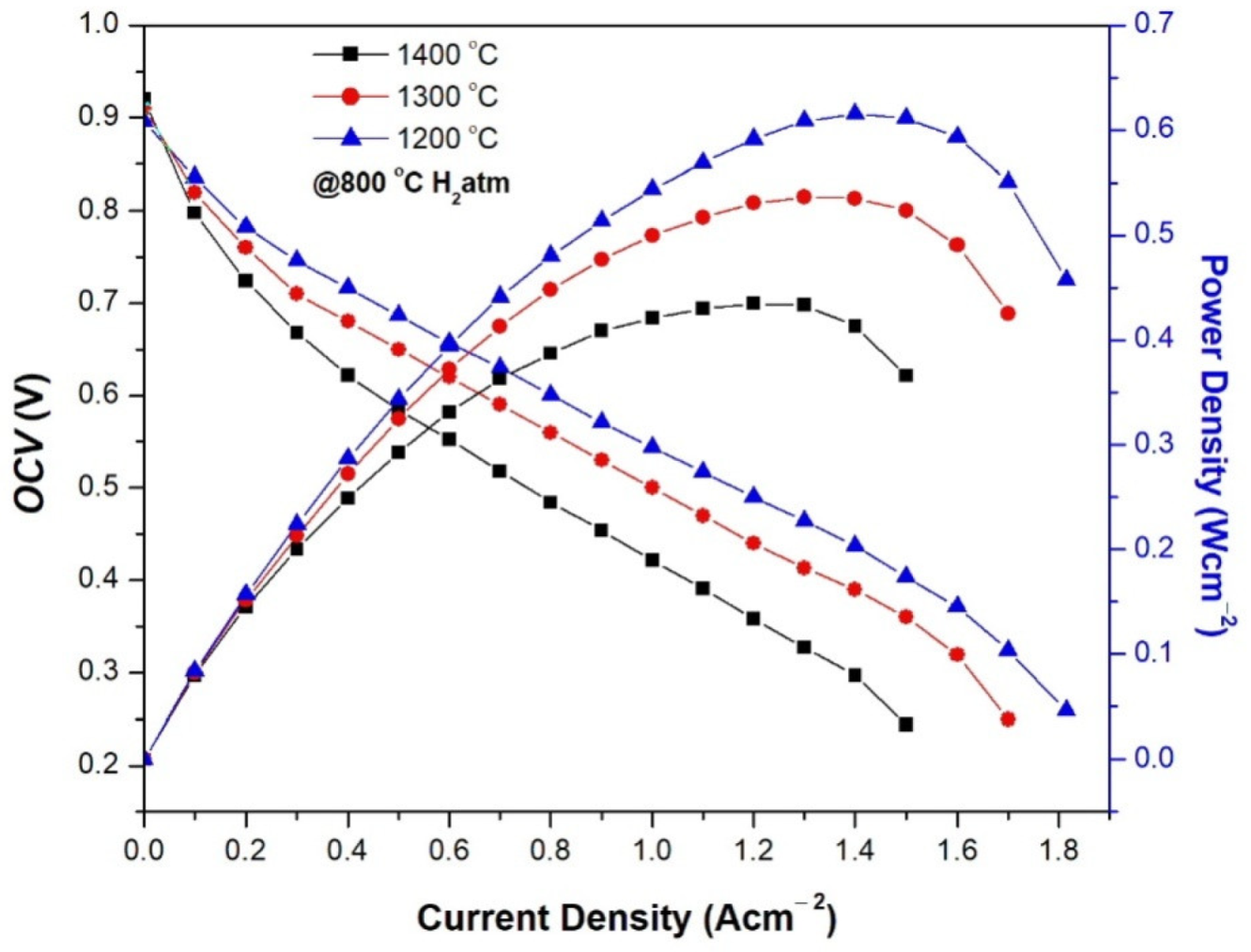Influence of Sintering Temperature on the Structural, Morphological, and Electrochemical Properties of NiO-YSZ Anode Synthesized by the Autocombustion Route
Abstract
:1. Introduction
2. Experimentation
Cell Fabrication
3. Results and Discussion
3.1. Structural Analysis
3.2. Morphology of NiO-YSZ
3.3. EDX Analysis
3.4. Thermal Analysis
3.5. Conductivity Measurements
3.6. Electrochemical Performance
4. Conclusions
Author Contributions
Funding
Data Availability Statement
Acknowledgments
Conflicts of Interest
References
- Fu, Q.; Li, Z.; Wei, W.; Liu, F.; Xu, X.; Liu, Z. Performance enhancement of planar solid oxide fuel cell using a novel interconnector design. Int. J. Hydrogen Energy 2021, 46, 21634–21656. [Google Scholar] [CrossRef]
- Tan, L.; Dong, X.; Chen, C.; Gong, Z.; Wang, M. Diverse system layouts promising fine performance demonstration: A comprehensive review on present designs of SOFC-based energy systems for building applications. Energy Convers. Manag. 2021, 245, 114539. [Google Scholar] [CrossRef]
- Irshad, M.; Idrees, R.; Siraj, K.; Shakir, I.; Rafique, M.; Ain, Q.U.; Raza, R. Electrochemical evaluation of mixed ionic electronic perovskite cathode LaNi1-xCoxO3-δ for IT-SOFC synthesized by high temperature decomposition. Int. J. Hydrogen Energy 2021, 46, 10448–10456. [Google Scholar] [CrossRef]
- Liu, F.; Duan, C. Direct-Hydrocarbon Proton-Conducting Solid Oxide Fuel Cells. Sustainability 2021, 13, 4736. [Google Scholar] [CrossRef]
- Abdelkareem, M.A.; Elsaid, K.; Wilberforce, T.; Kamil, M.; Sayed, E.T.; Olabi, A. Environmental aspects of fuel cells: A review. Sci. Total Environ. 2021, 752, 141803. [Google Scholar] [CrossRef] [PubMed]
- Hussain, S.; Yangping, L. Review of solid oxide fuel cell materials: Cathode, anode, and electrolyte. Energy Transit. 2020, 4, 113–126. [Google Scholar] [CrossRef]
- Irshad, M.; Khalid, M.; Rafique, M.; Tabish, A.N.; Shakeel, A.; Siraj, K.; Ghaffar, A.; Raza, R.; Ahsan, M.; Ain, Q.; et al. Electrochemical Investigations of BaCe0.7-xSmxZr0.2Y0.1O3-δ Sintered at a Low Sintering Temperature as a Perovskite Electrolyte for IT-SOFCs. Sustainability 2021, 13, 12595. [Google Scholar] [CrossRef]
- Inac, S.; Unverdi, S.O.; Midilli, A. A parametric study on thermodynamic performance of a SOFC oriented hybrid energy system. Int. J. Hydrogen Energy 2019, 44, 10043–10058. [Google Scholar] [CrossRef]
- Aman, N.A.M.N.; Muchtar, A.; Somalu, M.R.; Rosli, M.I.; Kalib, N.S. Overview of Computational Fluid Dynamics Modelling in Solid Oxide Fuel Cell. J. Adv. Res. Fluid Mech. Therm. Sci. 2018, 52, 174–181. [Google Scholar]
- Welander, M.M.; Zachariasen, M.S.; Hunt, C.D.; Sofie, S.W.; Walker, R.A. Operando Studies of Redox Resilience in ALT Enhanced NiO-YSZSOFC Anodes. J. Electrochem. Soc. 2018, 165, F152–F157. [Google Scholar] [CrossRef]
- Kim, J.W.; Bae, K.; Kim, H.J.; Son, J.W.; Kim, N.; Stenfelt, S.; Prinz, F.B.; Shim, J.H. Three-dimensional thermal stress analysis of there-oxidized Ni-YSZ anode functional layer in solid oxide fuel cells. J. Alloys Compd. 2018, 752, 148–154. [Google Scholar] [CrossRef]
- Li, F.; Zhang, J.; Luan, J.; Liu, Y.; Han, J. Preparation of Bi2O3-DopedNio/Ysz Anode Materials for Sofcs. Surf. Rev. Lett. 2017, 24, 1750092. [Google Scholar] [CrossRef]
- Abdalla, A.M.; Hossain, S.; Azad, A.T.; Petra, P.M.I.; Begum, F.; Eriksson, S.G.; Azad, A.K. Nanomaterials for solid oxide fuel cells: A review. Renew. Sustain. Energy Rev. 2018, 82, 353–368. [Google Scholar] [CrossRef]
- Pihlatie, M.H.; Frandsen, H.L.; Kaiser, A.; Mogensen, M. Continuum mechanics simulations of NiO/Ni-YSZ composites during reduction and re-oxidation. J. Power Sources 2010, 195, 2677–2690. [Google Scholar] [CrossRef]
- Wang, F.H.; Guo, R.S.; Wei, Q.T.; Zhou, Y.; Li, H.L.; Li, S.L. Preparation and properties ofNi/YSZ anode by coating precipitation method. Mater. Lett. 2004, 58, 3079–3083. [Google Scholar] [CrossRef]
- Irshad, M.; Siraj, K.; Raza, R.; Ali, A.; Tiwari, P.; Zhu, B.; Rafique, A.; Ali, A.; Kaleem Ullah, M.; Usman, A. A Brief Description of High Temperature Solid Oxide Fuel Cell’s Operation, Materials, Design, Fabrication Technologies and Performance. Appl. Sci. 2016, 6, 75. [Google Scholar] [CrossRef] [Green Version]
- Drożdż, E.; Wyrwa, J.; Rękas, M. Influence of sintering temperature and aging on properties of cermet Ni/8YSZ materials obtained by citric method. Ion 2013, 19, 1733–1743. [Google Scholar] [CrossRef] [Green Version]
- Ojeda, M.; Zhao, T.; Wang, H.; Xuan, J. Ni-YSZ Nanocomposite Synthesis: Mechanochemical vs. Novel Sol-Gel Method for Solid Oxide Electrolysers. Energy Procedia 2017, 142, 1095–1099. [Google Scholar] [CrossRef]
- Grgicak, C.M.; Green, R.G.; Du, W.F.; Giorgi, J.B. Synthesis and characterization of NiO-YSZ anode materials: Precipitation, calcination, and the effects on sintering. J. Am. Ceram. Soc. 2005, 88, 3081–3087. [Google Scholar] [CrossRef]
- Hargreaves, J.S.J. Some considerations related to the use of the Scherrer equation in powder X-ray diffraction as applied t heterogeneous catalysts. Catal. Struct. React. 2016, 2, 33–37. [Google Scholar] [CrossRef] [Green Version]
- Nityanand, C.; Nalin, W.B.; Rajkumar, B.S.; Chandra, C.M. Synthesis and physicochemical characterization of nanocrystalline cobalt doped lanthanum strontium ferrite. Solid State Sci. 2011, 13, 1022–1030. [Google Scholar] [CrossRef]
- Park, S.Y.; Na, C.W.; Ahn, J.H.; Song, R.H.; Lee, J.H. Preparation of highly porous NiO-gadolinium-doped cerianano-composite powders by one-pot glycine nitrate process for anode-supported tubular solid oxide fuel cells. J. Asian Ceram. Soc. 2014, 2, 339–346. [Google Scholar] [CrossRef] [Green Version]
- Zhu, X.; Lü, Z.; Wei, B.; Huang, X.; Zhang, Y.; Su, W. Asymmetrical solid oxide fuel cell prepared by dry-pressing and impregnating methods. J. Power Sources 2011, 196, 729–733. [Google Scholar] [CrossRef]
- Ahsan, M.; Irshad, M.; Fu, P.F.; Siraj, K.; Raza, R.; Javed, F. The effect of calcination temperature on the properties of Ni-SDC cermet anode. Ceram. Int. 2020, 46, 2780–2785. [Google Scholar] [CrossRef]
- Solovyev, A.A.; Ionov, I.V.; Kovalchuk, A.N.; Kirdyashkin, A.I.; Maznoy, A.S.; Kitler, V.D. Sintering ofnio/ysz anode layers for metal-supported solid oxide fuel cell. Adv. Mater. Res. 2014, 1040, 155–160. [Google Scholar] [CrossRef]
- Irshad, M.; ul Ain, Q.; Siraj, K.; Raza, R.; Tabish, A.N.; Rafique, M.; Idrees, R.; Khan, F.; Majeed, S.; Ahsan, M. Evaluation ofBaZr0.8X0.2 (X = Y, Gd, Sm) proton conducting electrolytes sintered at low temperature for IT-SOFC synthesized by cost effective combustion method. J. Alloys Compd. 2020, 815, 152389. [Google Scholar] [CrossRef]
- Irshad, M.; Siraj, K.; Raza, R.; Rafique, M.; Usman, M.; ul Ain, Q.; Ghaffar, A. Evaluation of densification effects on the properties of 8 mol% yttria stabilized zirconia electrolyte synthesized by cost-effective coprecipitation route. Ceram. Int. 2020, 47, 2857–2863. [Google Scholar] [CrossRef]
- Han, K.R.; Jeong, Y.; Lee, H.; Kim, C.S. Fabrication of NiO/YSZ anode material for SOFC via mixed NiO precursors. Mater. Lett. 2007, 61, 1242–1245. [Google Scholar] [CrossRef]
- Bueta, F.R.; Imperial, J.F.; Cervera, R.B. Structure and conductivity of NiO/YSZ composite prepared via modified glycine-nitrate process at varying sintering temperatures. Ceram. Int. 2017, 43, 16174–16177. [Google Scholar] [CrossRef]
- Fukui, T.; Ohara, S.; Naito, M.; Nogi, K. Performance and stability of SOFC anode fabricated from NiO/YSZ composite particles. J. Eur. Ceram. Soc. 2003, 23, 2963–2967. [Google Scholar] [CrossRef]
- Chiodelli, G.; Malavasi, L. Electrochemical open circuit voltage (OCV) characterization of SOFC materials. Ionics 2013, 19, 1135–1144. [Google Scholar] [CrossRef]
- Jin, C.; Yang, C.; Chen, F. Effects on microstructure of NiO—YSZ anode support fabricated by phase-inversion method. J. Membr. Sci. 2010, 363, 250–255. [Google Scholar] [CrossRef]







| Anode Material | Crystallite Size | ||
|---|---|---|---|
| 1200 °C | 1300 °C | 1400 °C | |
| NiO | 12.6 nm | 17.94 nm | 32.33 nm |
| YSZ | 13.66 nm | 21.38 nm | 39.03 nm |
Publisher’s Note: MDPI stays neutral with regard to jurisdictional claims in published maps and institutional affiliations. |
© 2022 by the authors. Licensee MDPI, Basel, Switzerland. This article is an open access article distributed under the terms and conditions of the Creative Commons Attribution (CC BY) license (https://creativecommons.org/licenses/by/4.0/).
Share and Cite
Irshad, M.; Rafique, M.; Tabish, A.N.; Ghaffar, A.; Shakeel, A.; Siraj, K.; Ain, Q.u.; Raza, R.; Assiri, M.A.; Imran, M. Influence of Sintering Temperature on the Structural, Morphological, and Electrochemical Properties of NiO-YSZ Anode Synthesized by the Autocombustion Route. Metals 2022, 12, 219. https://doi.org/10.3390/met12020219
Irshad M, Rafique M, Tabish AN, Ghaffar A, Shakeel A, Siraj K, Ain Qu, Raza R, Assiri MA, Imran M. Influence of Sintering Temperature on the Structural, Morphological, and Electrochemical Properties of NiO-YSZ Anode Synthesized by the Autocombustion Route. Metals. 2022; 12(2):219. https://doi.org/10.3390/met12020219
Chicago/Turabian StyleIrshad, Muneeb, Muhammad Rafique, Asif Nadeem Tabish, Abdul Ghaffar, Ahmad Shakeel, Khurram Siraj, Qurat ul Ain, Rizwan Raza, Mohammed Ali Assiri, and Muhammad Imran. 2022. "Influence of Sintering Temperature on the Structural, Morphological, and Electrochemical Properties of NiO-YSZ Anode Synthesized by the Autocombustion Route" Metals 12, no. 2: 219. https://doi.org/10.3390/met12020219
APA StyleIrshad, M., Rafique, M., Tabish, A. N., Ghaffar, A., Shakeel, A., Siraj, K., Ain, Q. u., Raza, R., Assiri, M. A., & Imran, M. (2022). Influence of Sintering Temperature on the Structural, Morphological, and Electrochemical Properties of NiO-YSZ Anode Synthesized by the Autocombustion Route. Metals, 12(2), 219. https://doi.org/10.3390/met12020219







